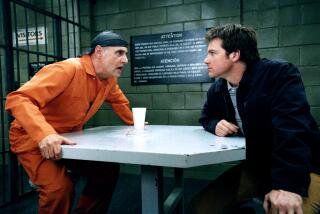There’s Something About a Providential Partnership : Movies: The Farrelly brothers find a kindred spirit in fellow Rhode Islander Michael Corrente for coming-of-age tale ‘Outside Providence.’
- Share via
Filmmaker Peter Farrelly recalls that when he was a Rhode Island teenager in the mid-1970s, no music affected him as deeply as early Bruce Springsteen. “It was the one good thing we had,” he says almost reverently. So even now he winces at what lay ahead.
“Disco was just beginning,” says the co-creator of last year’s “There’s Something About Mary,” “but guys were hanging on to that ‘60s long-hair thing. I remember feeling stuck in the middle. I had hair halfway down my back. All of a sudden everybody was going to discos and there’d be guys with the 90-mile-an-hour look doing these dances. . . . It was a different world suddenly.”
Disco is history, Springsteen’s got the band back together and Farrelly somehow survived the ‘70s (“not exactly my favorite decade”). He and his brother, Bobby, have gone on to build what has become a skyrocketing career making comedies like “Dumb and Dumber,” “Kingpin,” the aforementioned “Mary” and next year’s “Me, Myself and Irene,” with Jim Carrey.
And now the Farrellys have turned Peter’s semi-autobiographical novel, published in 1988, into a movie with the same name, “Outside Providence.” Directed by fellow Rhode Islander Michael Corrente (“I think he liked my book better than I did,” said Farrelly), it follows a pot-smoking Pawtucket teenager who gets shipped off to prep school. The coming-of-age film, humorous but with dramatic themes and relationships not found in other Farrelly brothers movies, marks the first time the two are producing and not directing. Corrente is co-writer with the Farrellys and co-producer.
In “Outside Providence,” Farrelly--a corduroy guy then, no jeans--wanted to capture realistically the Rhode Island of his youth and the transition after President Nixon’s resignation, away, he said, from the feeling of hope and change experienced through the ‘60s toward a growing apathy in the ‘70s.
The film’s fictional story, set in working-class Pawtucket in 1974-75, nevertheless draws from adolescent experiences of the three Rhode Islanders. The bell-bottoms and black-light posters are there, as are Steppenwolf and Steely Dan, but Corrente said he worked closely with production and costume designers to avoid campy stereotypes found in many 1970s movies. “We wanted it to be real, like the haircuts, without everybody having the huge Afros,” Farrelly said.
And this isn’t a change for the Farrellys, he says. “It’s Michael’s movie. He edited it. He shot it. He co-wrote it with us.”
‘I Sold Him the Rights for a Dollar’
Corrente, whose movies include “Federal Hill,” another film set in Rhode Island, and a screen adaptation of David Mamet’s “American Buffalo,” met Peter just after the book came out. “He [Corrente] was passionate about it, and at that point nobody was running around making my movies,” said Farrelly. “So I sold him the rights for a dollar.”
Corrente, who grew up in Pawtucket, sees the story as more his world than Peter’s, who grew up in nearby Cumberland, a more upscale town. “There’s a fun, crazy blue-collar attitude,” Corrente says of the neighborhood flavor he wanted in the movie, “where you don’t really know how to say what’s on your mind. You try your best but you usually end up [messing] it up anyway. But the intentions are always good and honest.”
In “Outside Providence,” main character Tim Dunphy (Shawn Hatosy), not known for his scholarship, spends his time atop a Pawtucket water tower, drinking, smoking and wondering where the girls are. His blue-collar, less-than-nurturing father, Old Man Dunphy (Alec Baldwin) refers to him as a sexual aid rather than use his given name. Farrelly says there was a water tower in his town, but it was so tall he climbed it only once. And high school was almost as scary.
“My first day I remember just being stunned,” says Farrelly. “The men’s room at my high school was like being at a Grateful Dead concert. People were smoking bones and passing out pills in different colors. It was complete anarchy.”
In the movie, when his friends’ smoke-filled Nova rear-ends a police car, Tim’s dad is called to the station and learns of his son’s drug use.
“I didn’t have a car, but my mother had a Valiant,” recalls Farrelly, who says his parents love his movies. “That was our big stoner car. I always drove, and people were always passing me something, and the head would fall off and burn the seat. My mother was just baffled how there could be 50 burn marks where your legs are.”
Old Man Dunphy uses connections to get Tim accepted into Cornwall Academy. Carrying his belongings in a plastic trash bag, Tim leaves his buddies behind in Pawtucket and heads for Connecticut and a second chance. He’s clueless at first and not too worried about it but begins to question his slacker ethic after hooking up with the well-heeled and motivated Jane Weston (Amy Smart).
Similarly, Farrelly was not his school’s brightest light--in part because of an open-campus policy allowing students to come and go as they pleased--so his alarmed parents sent him to the regimented Kent School, also in Connecticut, New England’s strictest coed boarding school at the time, he said.
A Time When Thumbing a Ride Was Endorsed
“I went dragging and screaming; I hated it there,” said Farrelly, who didn’t even know what a boarding school was. “You had to have your tie on and your top button buttoned at 7 a.m. at breakfast or you got five [work] hours,” he said. More serious infractions resulted in “socials,” times when a student wasn’t allowed to talk to anyone, discipline that Farrelly found difficult to accept.
What is considered safe, acceptable behavior in one decade can change as quickly as clothes and music. In “Outside Providence,” hitchhiking, for example, is preferred transportation, a view shared by Farrelly’s dad, a doctor. Peter and Bobby thumbed back and forth to high school and Little League games.
“I’d say, ‘Pop, we got a game. Come on, can ya take us?’ And he’d say, ‘Hey, whaddya think God gave ya a thumb for. Come on, get out there.’ If you didn’t hitchhike, you were just lazy.”
Corrente filmed on location in Providence and Pawtucket, where he enjoys the pull associated with popularity. Providence Mayor Vincent “Buddy” Cianci Jr., who can cite the Farrellys’ latest box-office grosses, helped arrange for the enormous Cranston Street Armory to be used as sound stage and production office.
To avoid drifting toward polyester and platform shoes, Corrente showed the ‘70s-inspired movie “Dazed and Confused” to production designer Chad Detwiller, who was 8 in 1974, and costume designer Annie Dunn, who spent her teens in rural Wales.
“It was a lovely little movie, but it’s like a cartoon, it’s so styled,” Dunn said. “Chad and I were determined it wasn’t going to be like that.”
Dunn wanted clothing, not costumes, and scoured 1970s yearbooks at Providence-area high schools and local family photographs. Old denim, heavy parkas, Army gear and “scruffy clothes” were used to contrast with the prep school’s uniforms and natural wools. Local radio stations publicized specific production needs.
“The story didn’t really lend itself to that glossy, kind of psychedelic colors, fun ‘70s look,” said Detwiller, who was kicked out of three high schools himself and who now lives in Newport, R.I. (where else?). “We were trying to do a more gritty, earthy look. We looked through old Sears catalogs, magazines. . . . We cut out ads for appliances, furniture, carpeting, wall paneling.”
Director Scrambles for Financing
Adding a final touch in some scenes meant dropping in blasts from the ‘70s, like the Allman Brothers’ “Eat a Peach” album cover, the ubiquitous “Footprints in the Sand” poem hanging on a wall, a variety of homemade bongs and “clackers” (colored resin balls connected with string). Budman bumper stickers were made from scratch, as were labels for cigarettes and the East Coast beer Narragansett. And who could throw darts in the ‘70s without hanging a David Cassidy Life magazine cover over the board?
One scene featured a 55-gallon drum that was turned into a giant bong, but Detwiller said that was more a result of the prop guys getting carried away than any creative decision.
With no stars in lead roles and material some saw as difficult, studios declined to finance “Outside Providence.” So Corrente hustled together a patchwork of investors, including doctors and lawyers, to cover the $7-million budget. Miramax Films purchased the finished film.
“It’s an impressive thing Michael’s done,” Farrelly said. “This is an independent movie. Michael raised the money. I had nothing to do with that. You have no idea the stress and pressure this guy was under. He would be filming on Thursday, and between shots he’d be on the phone with people trying to raise more money so he could pay people on Friday.”
More to Read
Only good movies
Get the Indie Focus newsletter, Mark Olsen's weekly guide to the world of cinema.
You may occasionally receive promotional content from the Los Angeles Times.










